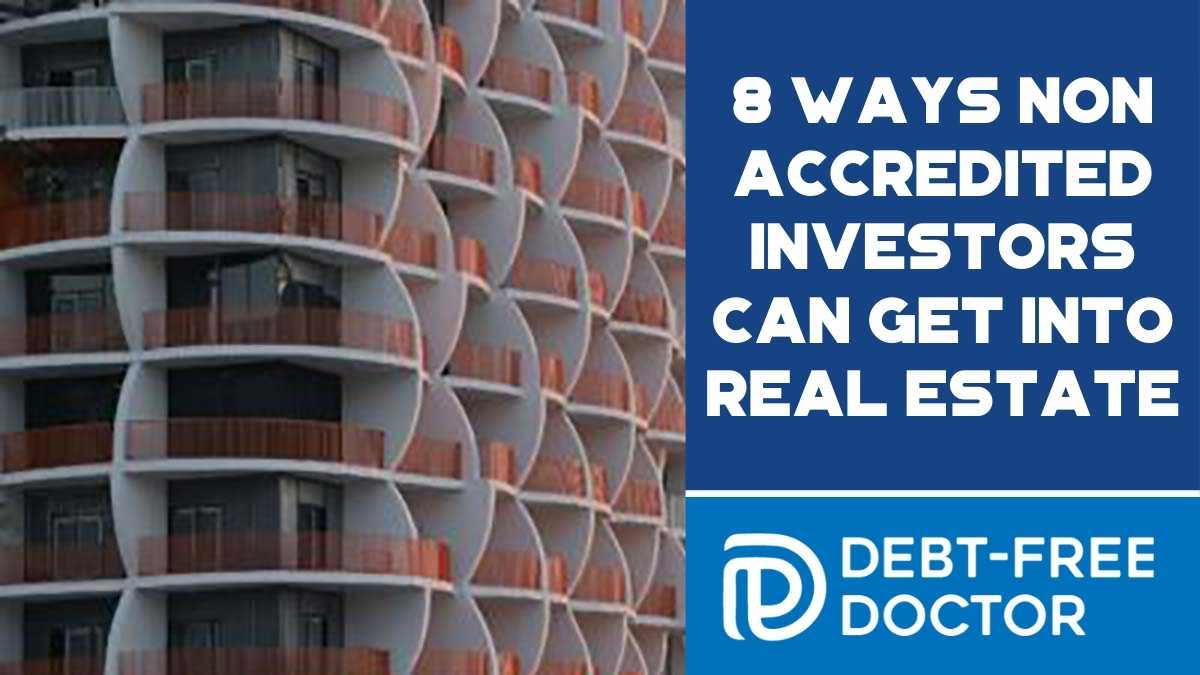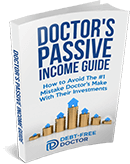8 Ways A Non Accredited Investor Can Invest in Real Estate
When I first started investing in real estate, I had no idea that certain investment opportunities were for people with a high income and/or net worth (accredited investors).
This is discouraging to new investors as they’re limited to what they’re able to invest in. This is the case with many new members of our Passive Investors Circle. After joining, many want to begin investing right away into passive deals not knowing that they’re not qualified to for most of them.
I get it as this can feel like a total slap in the face especially when they find out that there’s no online class or certification that they can take to become “one of them.”
So, what then?
Non Accredited Investor
Congratulations! If you’re not an accredited investor, and you’re reading this now, your level of awareness is impressive.
Most new investors start out by only “googling” terms like passive income and financial freedom, being completely unaware of accreditation and other complicated issues.
Beyond that, most people are just dreaming of “one day” when they reach a milestone like a promotion or a raise because they believe that achievement will allow them to invest.
So again, my hats off to you for focusing on learning about real estate investing.
How A Non Accredited Investor Can Invest In Real Estate
Hopefully this article can give you some encouragement because finding out that some real estate opportunities are not available to you is disheartening.
However, there exists an alternate list of other opportunities that even non accredited investors can get into.
Let’s get going….
8 Ways ANYONE Can Invest In Real Estate
- Buy and hold rentals
- House hacking
- Fix-and-flips
- BRRRR Strategy
- Private Lending
- Joint Venture Partnerships
- Real Estate Crowdfunding Platforms
- Private Real Estate Syndications
None of the above require you to be an accredited investor AND you can still build passive income.
#1 Buy and hold rentals
Most people are familiar with how having rental property works. You buy a home and rent it out.

The greatest perk to these types of investments is that you’re in charge. You can choose to manage it all yourself or hire a property management firm.
It’s your choice when to buy and when to sell, and you get to decide on the renovations.
The alternate to this power though, is the responsibility. Everything rests on your shoulders and when things go wrong that’s on you too. Clogged toilet at 3 AM? It’s YOU that has to answer that call!
This is one of the main reasons I chose to invest in the passive route. I didn’t want a second job.
Rental properties are definitely open to the non accredited investor, require a moderate level of work, and are long-term investments with a low-to-moderate risk.
Don’t Miss Any Updates. Each week I’ll send you advice on how to reach financial independence with passive income from real estate.
Sign up for my newsletter#2 House hacking
House hacking is one way many people “accidentally” become landlords. They might find a place with an upstairs and downstairs unit, for example, and quickly decide to rent out one portion of it.
Great news! That rental income helps pay for the mortgage on the property as a whole.
This is a great option for real estate in a steeper priced area, it’s open to non-accredited investors, requires a moderate level of work, and is a long-term investment with low risk.
#3 Fix and flips
If you’re the type of investor that likes to take a hands-on approach then fix and flips maybe just the thing you need to get started.
These investments are usually a short-term purchase where you repair and remodel the property yourself and “flip” it (sell it for a profit).

The downside is that it might take substantial capital to get started, especially if you’re in an expensive area. This maybe tough for the new doctor as they usually carry a boatload of student loan debt.
The cost to purchase the property, plus the value to fund the rehab, plus money to cover the mortgage payment until the property sells should all be set aside prior to making the deal.
You also face immediate market volatility and may have to hold the property longer than expected or sell for less than expected, which would cut into your potential profit.
It’s for these reasons that fix and flips typically carry a higher risk than some other options on this list.
#4 BRRRR strategy
The BRRRR strategy is a combination of the buy-and-hold and the fix-and-flip options.
It stands for:
- Buy
- Rehab
- Rent
- Refinance
- Repeat
First half
The first half of the strategy looks just like a fix-and-flip. You buy a property that needs some TLC and give the place a face-lift.
Second half
The second half of the strategy looks much more like a buy-and-hold. Once renovations are complete, you find tenants. Once rented, you do a cash-out refinance and repeat the process with another property.
Assuming after renovations were complete, the property’s value increased substantially, you may be able to pull out all of your original capital.
The BRRRR strategy is extremely powerful, open to a non accredited investor, requires a high level of work, and is a long-term investment option with moderate-to-high risk.
#5 Private lending
One side of real estate investing that can easily be overlooked is investing in debt.

For example, this is where you loan someone money to complete a fix-and-flip.
You don’t have to be hands-on in the home purchase, renovations, or home selling process, nor do you have to be an accredited investor.
Most beginner investors are still working full time. Combine that lack of time (but a surplus of money) with a cash-strapped go-getter ready to do all the dirty work, and you have a deal.
As an example, you could loan them the fix-and-flip money for 12 months at 10% interest. They turn the house around within the 12 month period, and you earn 10% on the loan.
Your risk is relatively low because it’s backed by the property, your workload is low, and you don’t have to be accredited for these short-term investments.
Join the Passive Investors Circle#6 Joint venture partnerships
If single-family homes spell B-O-R-I-N-G to you, multifamily or commercial real estate might pique your interest.

If you also have the capital plus skills to contribute, you might be a great potential joint venture (JV) partner.
A JV partnership is where a small group invests together and the property renovations and management tasks are split up between them.
Each person has an active role with no passive investors.
This type of opportunity is open to a non accredited investor, has a high level of work, a moderate level of risk, and a flexible timeline depending on the project.
#7 Real estate crowdfunding platforms
Real estate crowdfunding platforms are much like Kickstarter, but for real estate. These platforms contain opportunities for a variety of projects from fix-and-flips to large-scale value-add multifamily projects.
You invest capital in exchange for portion of the returns without having to do any of the work. Most of these types of opportunities are for accredited investors only.
However, there are a few real estate crowdfunding sites that offer REITs (real estate investment trusts) for non-accredited investors.
REITs don’t give you benefits of direct ownership, but they are great vehicles for passive investing and typically require low minimum investments with low risk and a low threshold of work involved.
#8 Private real estate syndications
Group investments where people pool their resources to invest in a large asset is a real estate syndication deal. At first glance, this may sound a lot like a joint venture situation.
However, JV investors each have a specific, active role in managing the property. In a real estate syndication, most of the investors are passive – meaning they won’t be hands-on with the property renovations or making any big decisions.
*This is the MAIN reason I almost exclusivity invest in these types of investments in the real estate category.
Many real estate syndications are only open to accredited investors, due to SEC regulations. However, there are a wide variety of opportunities open to non-accredited investors as well.
Since the opportunities for non-accredited investors aren’t able to be publicly advertised, you have to know someone who’s part of a general partnership to gain access.
This is where, as a non-accredited investor, you have to be willing to network with people to find deals that will be open to your non-accredited capital.
These deals require a low level of work (research and connection upfront) and carry low risk as a long-term investment.
Don’t Miss Any Updates. Each week I’ll send you advice on how to reach financial independence with passive income from real estate.
Sign up for my newsletterTakeaways
If you’re a new investor and therefore, not accredited at this point, keep up the good work educating yourself by reading these types of articles.
The more you learn, the quicker you’ll be on your way to building massive amounts of passive income which will allow you to live life on YOUR terms.
The 8 ways we highlighted today (out of the infinite number of possibilities) you can invest in real estate as a non-accredited investor are:
- Buy and Hold Rentals
- House Hacking
- Fix-and-flips
- BRRRR Strategy
- Private Lending
- Joint Venture Partnerships
- Real Estate Crowdfunding Platforms
- Private Real Estate Syndications
Realizing that certain opportunities are not available could get you down. But just because a deal is available to accredited investors, doesn’t mean it‘s that great and often, there are faster and more powerful ways for non-accredited investors to accumulate wealth through real estate, especially with some work.



